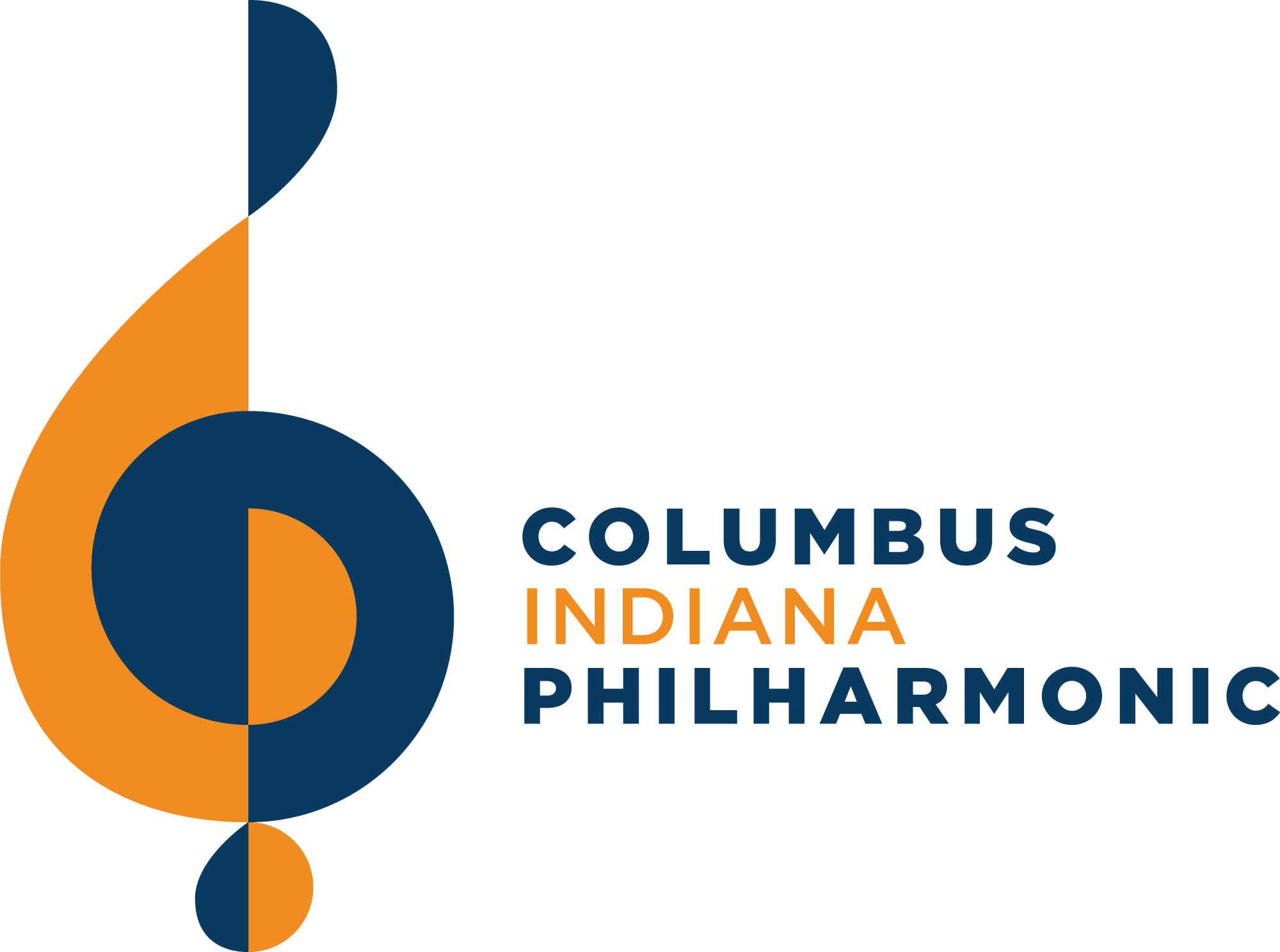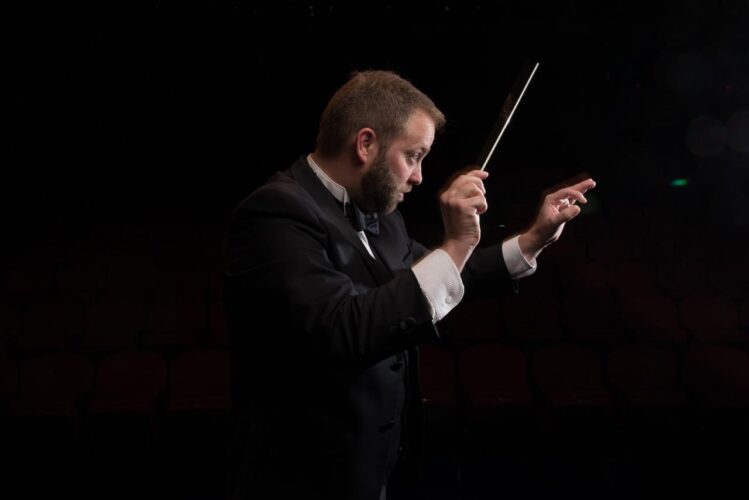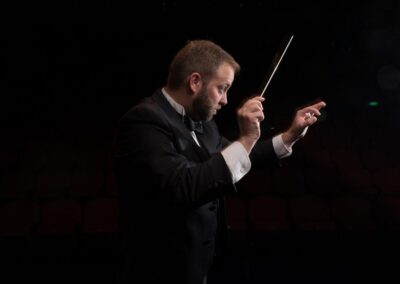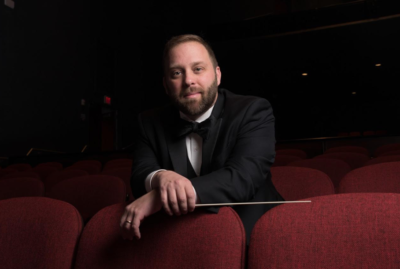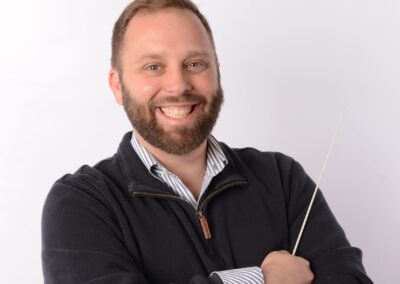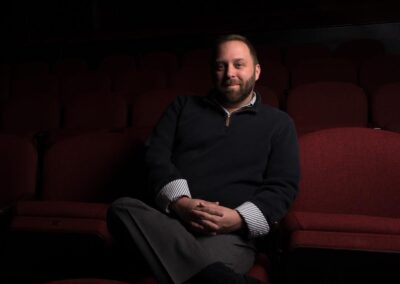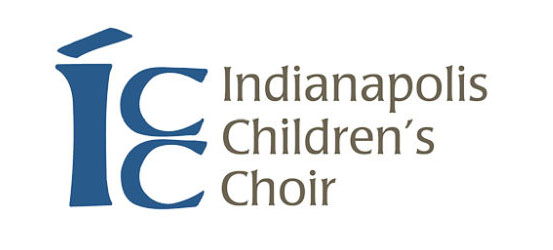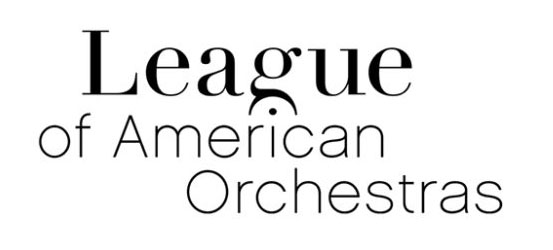ABOUT THE CONCERT
Come meet Conductor Finalist #5 at a sensational performance led by Maestro Charles Latshaw!
When longtime conductor and artistic director David Bowden announced that he would retire after our 2021-2022 season, more than 100 bandleaders applied to fill his podium. Now, the CIP has narrowed its search for a new artistic director to 6 finalists.
Each finalist will spend a week in our community, meeting our patrons (you!), working with our musicians, and showcasing their talent during one of the season’s concerts. Each performance will feature music selected by the candidate, giving us the opportunity to experience a diverse variety of music this year.
Golden Days
Saturday • March 25, 2023
Doors Open 6:45 PM
Concert Starts 7:30 PM
Columbus North Erne Auditorium
1400 25th Street
Columbus, IN 47201
MAESTRO BIOGRAPHY
American conductor Charles Latshaw is in his sixth season as Music Director of the Flagstaff Symphony Orchestra in Arizona and maintains his position as Music Director of the Grand Junction Symphony Orchestra in Colorado, a post he has held since 2016. He was Assistant Conductor of the Columbus Indiana Philharmonic and Music Director of the Philharmonic Youth Orchestra and Ensemble from 2005-2009.
Prior to 2016 Latshaw was director of the Kent Blossom Music Festival and the Kent State University Orchestra and formerly Artistic Director and Conductor of the Bloomington Symphony Orchestra in Indiana. Latshaw has also held positions with the Indianapolis Symphony Orchestra, tthe Washington Sinfonietta and the Ars Nova Chamber Orchestra. He holds the distinction of being selected by members of the Vienna Philharmonic as their Herbert von Karajan Conducting Fellow in 2007.
Firmly dedicated to bringing orchestral music to new audiences, particularly the young, he has taught band, choir, general music and musical theatre to students of all ages. In this capacity he served as faculty for numerous summer programs including the Rocky Ridge Music Center, the Columbus Indiana Philharmonic Strings Camp and the Palace Theatre summer programs. Additionally, he has led “Side by Side” concerts for high school students with the Indianapolis Symphony, the Columbus Indiana Philharmonic and the Bloomington Symphony Orchestra.
In his efforts to expand audiences for newly-created, accessible contemporary compositions, Latshaw has premiered more than thirty new works for chamber groups, youth orchestras and full symphony orchestras, many of his own commissioning.
Off the podium, he has held positions as principal trumpet in orchestras in Ohio, New Hampshire and Massachusetts, performing also with jazz bands as trumpeter, vocalist and band leader. On the stage he has appeared in acting and singing roles with the Palace Professional Theatre of Manchester and the New Hampshire State Opera. These various activities have led to touring in Germany, Austria, the Czech Republic and the U.S.
Charles Latshaw holds a master’s and doctorate degree in instrumental conducting from the Indiana University Jacobs School of Music. Now living in Colorado with his wife Kelley, they spend their free time in the woods, camping, hiking and skiing in the beauty of the Rockies.
THE REPERTOIRE
Coleman – In Good King Charles’s Golden Days
Chabrier – Suite Pastorale
Brahms – Symphony No. 1
PROGRAM NOTES
In Good King Charles’s Golden Days: A Symphonic Overture • Linda Robbins Coleman
Composed in 1989
Est. Duration: 7 minutes
Linda Robbins Coleman is a native of Des Moines, Iowa, graduated from Drake University, and studied with the Greek National Theatre. From 1977-97 she was Drake Theatre’s resident composer and scored thirty-five plays. Coleman was the first Iowa woman to become Composer-in-Residence with any orchestra, serving with the Cedar Rapids Symphony Orchestra from 1994-96 and 2001-02; and the Wartburg Community Symphony from 1992-2002. In 1981, Coleman and her husband founded the Friends of Drake Arts. In 1987, she co-founded the Iowa Composers Forum and served as its chief administrator for ten years. She spent fifteen years on the Iowa Arts Council performing artist and education rosters. For four decades she was a collaborator and research partner with Professor William S. E. Coleman. She has owned Coleman Creative Services since 1976. Awards include Drake University’s Alumni Achievement Award and Dignitas Society; and Sigma Alpha Iota’s Member Laureate.
From the composer:
In 1989 when I was commissioned to write overtures and incidental music to George Bernard Shaw’s 1939 masterpiece, “In Good King Charles’s Golden Days,” I was confronted with the daunting task of capturing the play’s spirit in music. First, to evoke a sense of the late 17th century I felt the use of a harpsichord was mandatory. Since the play veered into 20th century ideas, including quantum physics, I wanted to include modern musical ideas as well.
The play consists of brilliant and often fiery arguments between King Charles II, Isaac Newton, Nell Gwynn, George Fox, James, the Duke of York, Godfrey Kneller, and Queen Catherine of Braganza. Musically the audience will find themes reflecting these characters and their brilliant dialogue dashing through various sections of the orchestra in a merry romp.
Since the Cedar Rapids Symphony Orchestra premiered it in April, 1995, “Charley” has been performed and broadcast throughout the United States and abroad with orchestras ranging from the Milwaukee Symphony to various professional, amateur, and youth orchestras. In 1999 “Charley” went to England – birthplace of both King Charles and the play that inspired the music. This occasion was my British debut.
Suite Pastorale • Emmanuel Chabrier
Composed in 1887
Est. Duration: 21 minutes
I. Idylle
II. Danse villageoise (Rustic Dance)
III. Sous bois (Under the Trees)
IV. Scherzo-valse
Emmanuel Chabrier was a French Romantic composer and pianist. His bourgeois family did not approve of a musical career for him, and he studied law in Paris and then worked as a civil servant until the age of thirty-nine while immersing himself in the modernist artistic life of the French capital and composing in his spare time. From 1880 until his death he was a full-time composer.
Although known primarily for two of his orchestral works, España and Joyeuse marche, Chabrier left a corpus of operas, songs, and piano music, but no symphonies, concertos, quartets, sonatas, or religious or liturgical music. His lack of academic training left him free to create his own musical language, unaffected by established rules, and he was regarded by many later composers as an important innovator and a catalyst who paved the way for French modernism. He was admired by, and influenced, composers as diverse as Debussy, Ravel, Richard Strauss, Satie, Stravinsky, and the group of composers known as Les six. Writing at a time when French musicians were generally proponents or opponents of the revolutionary music of Richard Wagner, Chabrier steered a middle course, sometimes incorporating Wagnerian traits into his music and at other times avoiding them.
In 1880, while Chabrier was on a vacation in the resort town of Saint-Pair, he wrote a set of ten short piano vignettes titled Pièces pittoresques. He gave them their first performance in Paris in 1881 to much acclaim from other French composers including César Franck, who remarked he had “just heard something exceptional.” Over the next seven years, Chabrier gradually re-orchestrated four of those short piano works into the Suite pastorale for orchestra.
The Idylle, marked ‘Allegretto avec fraîcheur et naïveté’ (A little fast with freshness and naivety) is a simple song with a pizzicato accompaniment. The composer Francis Poulenc, when he first heard the piece in 1914, wrote “a harmonic universe suddenly opened up before me and my music has never forgotten that first love kiss.”
The Danse villageoise (Rustic Dance) is meant to depict a simple dance in a remote French village. It follows a fairly standard ternary form – an opening in A minor, a trio in A major, and a recapitulation in A minor.
Sous bois (Under the Trees) – Chabrier was a great collector of Impressionist paintings. Much of his personal collection now hangs in museums. Sous bois is Chabrier’s own impressionism of a sort in that the music, with its gently undulating cellos and constantly changing keys effectively evokes an impression of the forest undergrowth and shifting light among the leaves of the trees. This piece was a great influence on later impressionistic French composers, Claude Debussy and Maurice Ravel.
The Scherzo-valse (Joke-waltz) was the conclusion of the original set of ten piano pieces, just as Chabrier has used it as the conclusion of his Suite pastorale. It’s a lively, jovial waltz, with a similar country-fied feel as the Danse villageoise. Likewise, it follows the same ternary pattern, with opening material in D major, a trio in Bb major, and a return to the sprightly music of the beginning.
Symphony No. 1 in C minor, Op. 68 • Johannes Brahms
Composed in 1876
Est. Duration: 45 minutes
I. Un poco sostenuto
— Allegro
— Meno allegro
II. Andante sostenuto
III. Un poco allegretto e grazioso
IV. Adagio
— Più andante
— Allegro non troppo, ma con brio
— Più allegro
Brahms was deeply affected by the nine symphonies of Ludwig van Beethoven. He was 21 years old when he first heard Beethoven’s Ninth in 1854 (some 30 years after its composition). He vowed then that he would write a symphony, but it would take another 22 years before the first Brahms symphony would come to fruition. Brahms’ closest friend, Robert Schumann, wrote to the famous violinist Joseph Joachim in 1854,
But where is Johannes? Is he
not yet ready to let drums and
trumpets sound? He should
always keep in mind the
beginning of the Beethoven
symphonies; he should try to
make something like them.
In the interim, Brahms wrote several other pieces that initially began as symphonies, but gradually morphed into other projects. In 1854 he wrote the first sketches of a symphony in D minor (the same key as Beethoven’s Ninth) which eventually became a sonata for two pianos. He tried again to write a symphony in D minor, which would become his first piano concerto – a monumental work, symphonic in its length and form. And Brahms’ two Serenades, a first in D major and a second in A major, are both complete symphonies in form, but with extra movements added.
Perhaps Brahms was uncomfortable attaching the title “Symphony” to any of his works in this period of his life, afraid that his pieces wouldn’t measure up to the great achievements of his Viennese symphonic predecessors, Beethoven, Mozart, and Haydn. He was a careful crafter of his own future image – often burning any composition that he didn’t feel was worthy of posterity. Whatever his reasons, Brahms worked and reworked his sketches for the first symphony for more than two decades to produce this piece, which indeed lets “drums and trumpets sound.” And the beginning (and ending) of the symphony surely evokes Beethoven’s own masterpieces.
The symphony begins in C minor, not the D minor of Beethoven’s Ninth but the C minor of Beethoven’s Fifth. And the pounding timpani, on repeated C naturals, is a clear homage to Beethoven’s similar timpani line in the transition from the third to the fourth movement. Later in Brahms’s first movement, Horns blare out a series of repeated four notes, evoking the ba-da-da-duuuuuum of Beethoven’s Fifth. The first movement follows a very traditional sonata form, with a first theme, a secondary theme, a development, and a recapitulation – a form routinely followed by Haydn, Mozart, and Beethoven, but rather old-fashioned by 1876 when the Germanic orchestral world was split between traditionalists like Brahms, and non-conformists like Wagner. The movement builds dramatically and powerfully to its conclusion, but finishes gracefully in C major.
And yet, for all the power and grandeur of the first movement, Brahms could be a gentle, thoughtful, emotional, often melancholy composer. Through all four of his symphonies, the middle movements represent the best of this side of Brahms.
But the finale is the real showstopper in Brahms’ first symphony. While the piece is “absolute music,” meaning it has no specific programmatic aspects, the fourth movement’s drama seems to evoke a clear story, even if the details are left to the listener’s imagination. It begins with a quiet, brooding introduction and a small pizzicato rainstorm, quickly accelerating toward a musical downpour. Dark clouds seem to cover the sky before the music breaks into a peaceful C major, followed by a horn call reminiscent of an alphorn. Brahms wrote in a letter to Clara Schumann that the horn melody calls out “Hoch auf’m Berg, tief im Tal, grüß ich dich viel tausend mal!” (High on the mountain, deep in the valley, I greet you a thousand times!)
The horn call is followed by a melody deeply reminiscent of the Ode to Joy melody from Beethoven’s Ninth symphony. (In fact, the underlying harmonies and length of phrases match exactly, and the two melodies could be played quite effectively at the same time.) After the premiere, as many critics and fans of the piece alike commented on this melody’s similarity to Beethoven’s, Brahms finally admitted “any ass can see that.” This theme builds in strength and joyfulness as the finale rises to a great conclusion.
Brahms’ first symphony has often been referred to as “Beethoven’s Tenth,” which is an approbation I’m sure he was very proud of.
– Maestro Charles Latshaw
